PREHISTORIC SHAMAN ART..
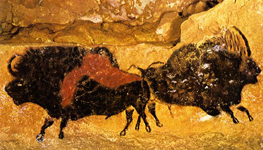

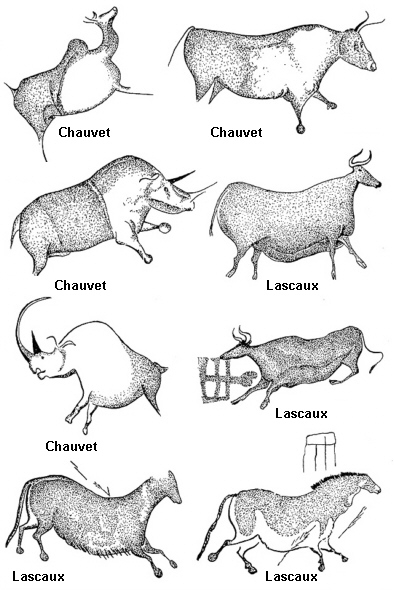


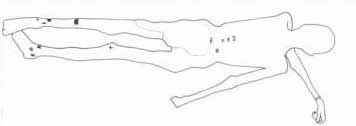


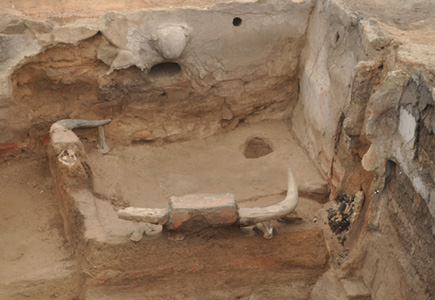
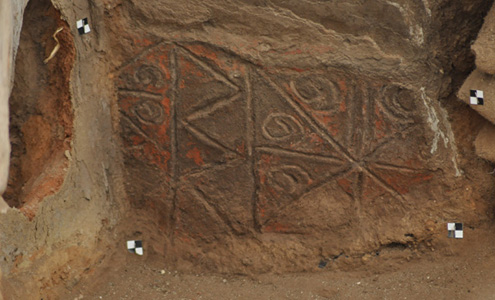
>> View www.ancientcraft.co.uk in a larger map
- Posted by ቸኝጵVláDá Súi GeNeRisኔጡ። on August 13, 2013 at 10:07am in SHAMAN'S GATE
- Back to SHAMAN'S GATE Discussions
PREHISTORIC ART

Most people think of cave paintings, when ancient art is mentioned, however there is much more. At the beginning of the Upper Paleolithic era of prehistory (from 40,000 BCE onwards), fine art suddenly came to Europe. These early forms of early art were either portable sculptures (mobiliary art), often of small female "venus figurines", or pictures and symbols that are painted, drawn or carved on the walls and ceilings of caves (parietal art). Later on, art became more integrated into settlements and daily life.
Pigments and Art Kits
In 2008 Archaeologists discovered two sets of art kits a cave in South Africa. The team of researchers, led by Professor Christopher Henshilwood from the universities of Bergen and Witwatersrand, believe that the orche was used for forms of artwork.
The two tool kits thought to be 100,000 years old, includes abalone shells, ochre, bone, charcoal, grindstones and hammerstones. The ochre – made from soft rock with red or yellow pigments - was probably ground into a fine powder by the use of quartzite cobbles, before being mixed and heated with crushed stones or bones in the abalone shells. Microscopic inspection of the abalone surfaces reveals a "high water mark" on the shells' inner wall, as evidence that an unknown liquid, probably urine, blood, animal fats or water was used for paint mixing.
As a painting pigment, ochre is a mixture of fine clay and iron oxide that exists in four forms:- Yellow/Gold ochre: Fe2O3 • H2O, a hydrated iron oxide
- Red ochre: Fe2O3, is the anhydrate of yellow ochre, which turns red when heated because heat drives off the water ligands
- Purple ochre: is identical to red ochre chemically but of a different hue caused by different light diffraction properties associated with a greater average particle size
- Brown ochre: (Goethite), also partly hydrated iron oxide (rust)
In addition to the Pigment, there are two other elements needed to make a usable paint: the Binder - this is required to keep the paint together and allows it to stick to the surface being painted; the Extender is a liquid that allows the paint to stretch over a larger surface area and typically urine, blood, animal fats or water would be used.
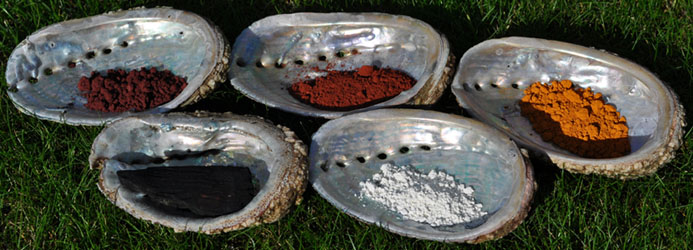 |
My prehistoric art kit comprises powdered purple, red and yellow ochres at the back, charcoal (made from English willow charcoal - a less harmful alternative to the manganese dioxide (MnO2) which was used by prehistoric cave painters) and white china clay in the front abalone shells. |
Ochre is sometimes associated with early human burials, such as the Neanderthal skeletons at Le Moustier and La Chapelle-aux-Saints. However one of the most famous uses of red ochre at a burial, was of a young man who died 23,500 years ago - the so called the "Red Lady" of Paviland. The oldest anatomically modern human remains found in the UK (now in the Oxford University Museum of Natural History - below right), his red dyed bones were discovered between 18th and 25th January 1823 by Rev. William Buckland, during an archaeological dig at Goat's Hole Cave in South Wales. In his book Reliquiae Diluvianae (Evidence of the Flood), Rev. Buckland stated:
 | "I found the skeleton enveloped by a coating of a kind of ruddle ... which stained the earth, and in some parts extended itself to the distance of about half an inch [12 mm] around the surface of the bones ... Close to that part of the thigh bone where the pocket is usually worn surrounded also by ruddle [were] about two handfuls of the Nerita littoralis [periwinkle shells]. At another part of the skeleton, viz in contact with the ribs [were] forty or fifty fragments of ivory rods [also] some small fragments of rings made of the same ivory and found with the rods ... Both rods and rings, as well as the Nerite shells, were stained superficially with red, and lay in the same red substance that enveloped the bones." |  |
One mine in UK where ochre pigments are still extracted by Free Miners is Clearwell Caves (Gloucestershire). Archaeological evidence indicates that mining for ochre began in the Forest of Dean area at least 4,500 years ago. A small number of mining hammer stones, shaped by the pecking technique, have been found locally and a bear resemblance to stones found at other site mining sites, such as the Alderley Edge copper mines (Cheshire) and Les Mines De Cabrières (SW, France). Extensive iron and coal working at Clearwell Caves was there during Roman times. When the Roman Empire moved into the Forest of Dean, the local miners may have remained free from direct Imperial control on condition they supply the Romans with their produce; this may have been the origin of the Free Mining system.
Prehistoric artists probably employed a wide variety of painting methods, working by animal fat candlelight in the depths of caves. The flickering light would have made their paintings almost move and come alive. It is likeIy the artists painted with their fingers first and later used pointed sticks, bone, pads of moss wrapped in hide or brushes made of animal hair, feathers or vegetable fibre. Ochre crayons were also used to apply pigment directly onto the surface. Local materials and possibly customs would determine the range of materials that could have and would have been used. My prehistoric paintbrush kit (right) comprises the following:
They also used spray painting techniques, by spitting out the mixed paint from their mouths and even using reeds or specially hollowed bones - saliva acts as a binder. In some sites it is believed that wooden scaffolding may have been used to paint the images on high walls and ceilings. | 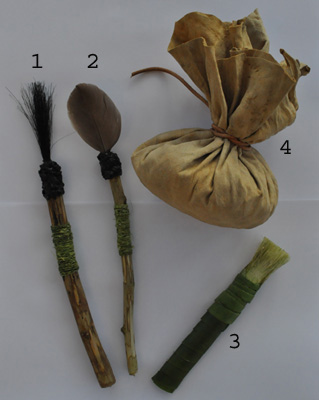 |
Oldest Known Art
Cupules are the earliest form of art and have been found on every continent except Antarctica. The actual term "cupule" was invented by archeologist Robert G. Bednarikto to describe simple, round hemispheric cavities that used to be known as "pits", "hollows", "cups", "cupels", "cup stones", "pitmarks", "cup marks" - even "pot-holes". The oldest known art dating from at least 290,000BCE is the series of Cupules discovered an ancient quartzite cave called Auditorium Cave, Bhimbetka, Madhya Pradesh (north central India). The cave is a 25m long horizontal cave and in the centre stands an enormous boulder called Chief's Rock (2.5m high and 3.4m wide). In 1990, nine cupules with evidence of a red pigment were found on Chief's Rock and in 1991a further cupule was found with meandering line next to it. These were covered by deposits from the Acheulian and later periods, so allowing dating. However later research by other dating methods (micro-erosion analysis) suggested that these cupules were made 700,000 years ago. |  |
Rock/Cave Art
Rock or Cave art can help us understand more about the ways of our early ancestors, such as how they hunted and ate, how they viewed and understand the world around them. Rock art is generally divided into either Petroglyphs (carvings into stone surfaces), Pictographs (rock and cave paintings) orPetroforms (art made by aligning or piling natural stones).
The most spectacular examples of Pictographs have been discovered in Spain and France, where archeologists have found around 350 caves containing Paleolithic artworks (one of the most famous example is a Lascaux in southwestern France). Other decorated caves have been found in many parts of the world, including Africa, Argentina, Australia, India and China.
Lascaux is the setting of a complex of caves near the village of Montignac, famous for its Paleolithic cave paintings, estimated to be at least 17,000 years old. The cave was discovered on 12th September 1940 by four teenagers (Marcel Ravidat, Jacques Marsal, Georges Agnel and Simon Coencas). In 2008 British scientists dated the paintings with the U/Th method and concluded that parts of the artworks are between 25,000 and 35,000 years old.
The cave contains nearly 2,000 figures, which can be grouped into three main categories — animals, human figures and abstract symbols. Over 900 can be identified as animals and 605 of these have been precisely identified, such as yellow mare, known as the Chinese Horse, in the Axial Gallery (shown below); the other 354 horses are of all colours, plain, composite, chestnut, black, bays, grayish yellow and dappled, with summer and winter coats. The most famous section of the cave is The Great Hall of the Bulls where bulls, horses and stags are shown.

The pigments used to paint Lascaux came from readily available minerals such as red, yellow, brown and purple orche, charcoal and manganese dioxide for black and white china clay - there are 25 tints, including 10 reds, 6 yellows, 6 blacks, and 1 white. No brushes have been found, so it is likely that the broad black outlines were applied using mats of moss or hair, or even with chunks of raw color. The surfaces appear to have been covered by paint blown directly from the mouth, from bark trays or through a tube and colour-stained, hollowed-out bones have been found in the caves. The discovery of artificial holes in the walls have suggested that wooden scaffolding was used, to allow the artists to reach inaccessible places, but without any natural light, these works could only have been created simply with the aid of torches or stone lamps filled with animal fat.
Open to the public in 1948, the carbon dioxide produced by 1,200 visitors per day had visibly damaged the paintings and it was closed to the public in 1963 in order to preserve the art. An air recirculation system was installed in 1968 to help Lascaux’s natural air flow and was used during the wettest seasons of the year; this was replaced in 2000. Since 1998, Lascaux has been attacked by a series of molds, Lichen, fungi (Fusarium Solani) and bacteria. When Spanish artist Pablo Picasso (1881 – 1973) visited the caves in the 1940's, he remarked "We have invented nothing".
To allow the public to get a glimpse of the art, Lascaux II was opened in 1983 at a cost over 500 million francs. The result of eleven years painstaking work by twenty artists and sculptors, using the same methods and materials as the original cave painters.
 |  |
LASCAUX - THE PREHISTORY OF ART This film investigates the prehistoric cave paintings at Lascaux. The release features a documentary by Alain Jaubert and a short film by Roger Verdier. | CAVE OF FORGOTTEN DREAMS Werner Herzog gains exclusive access to film inside the Chauvet caves of Southern France, capturing the oldest known pictorial creations of humankind in their astonishing natural setting. |

Repetitive Symbols (??)
A study by Genevieve von Petzinger (University of Victoria) has identified 26 symbols that repeatedly appear as prehistoric art over 25,000 years over four continents. Von Petzinger and professor April Nowell studied the ancient symbols from 146 different sites in France and was able to compare the signs over much a larger scale than had previously been attempted. The 26 specific signs may provide some evidence that a common graphic code was being used by ancient humans after their arrival into Europe from Africa. At least 19 symbols were used frequently (circles, lines, triangles and spirals) over many thousands of years which could indicate consistent abstract ideas such as life and death. Von Petzinger (right) and Nowell’s findings were reported in New Scientist and their research continues to explore the meaning of the symbols. |
 |  |  |  |  |  |  |  |  |  |  |  |  |
Aviform | Circle | Claviform | Cordiform | Crosshatch | Cruciform | Cupule | Dot | Finger Fluting | Flabelliform | Half Circle | Line | Negative Hand |
 |  |  |  |  |  |  |  |  |  |  |  |  |
Open Angle | Oval | Pennifrom | Pectifrom | Positive Hand | Quadrangle | Reniform | Scalarform | Serpentform | Spiral | Tectiform | Triangle | Zig Zag |
Moving Pictures (??)
French Archaeologist Marc Azéma (University of Toulouse–Le Mirail Culture and member of APEC) and independent French artist Florent Rivère suggest that by around 30,000 BP Paleolithic artists may have used "animation effects" in their cave paintings, which would explain why multiple heads or limbs can be seen. Azéma spent 20 years researching Stone Age animation techniques, by isolated 53 figures in 2 French caves (including Lascaux) that appear to superimpose two or more images to represent gallop, head tossing, and tail shaking. To render the animation, Azéma deconstructed each image into single animal elements and then superimpose it in successive images on top.
Venus Figurines
Venus figurines is a common description of around 200 of prehistoric statuettes (from the Upper Paleolithic and Neolithic periods) of females, mostly found in Europe and the far east. Most of the figurines are roughly oval-shaped, with the head and legs tapering away with relatively no detail. The widest point in the middle (hips/belly) often has certain parts of the human anatomy are exaggerated, such as large breasts, buttocks and thick thighs. They were carved by Stone Age sculptors in all manner of different materials, ranging from soft stone (steatite, calcite or limestone), wood, ivory and bone or ceramic clays.
Here is a selected list of the oldest and most famous examples of prehistoric venus figurines:
Lower Paleolithic Venuses:
Upper Paleolithic Venuses:
Mesolithic and Neolithic Venuses:
|
|
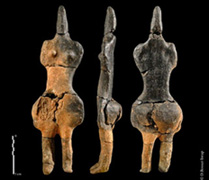 | The most recent Venus find (December 2011) comes from the left bank of the River Somme in northern France and has been called the Lady of Villers-Carbonnel. Believed to be over 6,000 years old, the 21 cm figurine dates from the localChasséen culture (4,300 - 3,600 BC) was made from local earth or clay and is similar to other venuses found across the Mediterranean region. The venus was found in five or six of fragments amongst the ruins of a neolithic kiln on a dig near Villers-Carbonnell, by a French INRAP archaeology team led by Françoise Bostyn. The dig is a result of the construction of a 60 mile long and 50m wide canal to allow barges to link the Seine and Rhine to ports in Belgium. The French government's National Institute for Preventive Archaeological Research INRAP was given the funds to explore the possible 77 sites to be uncovered. |
>> Make you own Lady of Villers-Carbonnel venus figurine
Body Art
Body Art, or more commonly referred to as tattoos, has been practiced for centuries in many cultures spread throughout the world. The oldest known tattoos belong to Ötzi the 5,300 year old Iceman, who had 57 carbon tattoos consisting of simple dots and lines or crosses on his lower spine, behind his left knee and on his right ankle. The tattoos are blue and black, with some are more visible than others. They were probably made by first cutting lightly into his skin, and then rubbing charcoal into the incisions, according to Maria Anna Pabst (researcher at the Medical University of Graz, Austria) who applied light and electron microscopes to minutely thin sections of several tattoos as well as a non-tattooed flesh from his inner thigh.


Ötzi's tattoos were originally thought to be of ornamentation or religious value, however they were found in places on his body that would normally be covered by hair or clothing. As non-ornamental tattoos have previously been found in similar locations on mummies in Siberia and South America, experts from three acupuncture societies examined the locations of each tattoo and speculated they were of therapeutic importance. In their opinion, nine tattoos could be identified as being located directly on, or within six millimeters of, traditional acupuncture points. Two more were located on an acupuncture meridian and one tattoo was used as a local point. The remaining three tattoos were situated between 6-13mm from the closest acupuncture point.
X-rays of the ice man's body revealed evidence of arthritis in the hip joints, knees, ankles and lumbar spine. Further analysis showed that his intestines were filled with whipworm eggs, which can cause severe abdominal pain. The experts remarked that "the tattoos could be viewed as a medical report from the stone age, or possibly as a guide to self-treatment marking where to puncture when pains occur." If this is true, acupuncture may be 2000 years older than originally thought.

The first written reference to the word, "tattoo" (or Samoan "Tatau") appears in the journal of Sir Joseph Banks (1743-1820), the naturalist aboard Captain Cook's ship the HMS Endeavor in 1769: "I shall now mention the way they mark themselves indelibly, each of them is so marked by their humor or disposition".
To view Otzi's tattoos in detail 
Settlement Art
60km west of Konya (Turkey) is the oldest known Neolithic settlement called Çatalhöyük (the word 'höyük' means 'mound') . The site was first discovered in 1958 by James Mellaart and excavated between 1961 and 1965. Mellaart suggested that the village was occupied from between 7,000 and 5,500 BC. Since 1993 a team of archaeologists, led by Cambridge archaeologist Professor Ian Hodder, has been carrying out new excavations in order to understand more the people who once inhabited the site, which has a number of wall paintings depicting animals and hunting scenes.
The small museum shows some of the artefacts founds on site and displays characteristic artwork (see below).
At the entrance to the site is a reconstruction of one of the dwellings - two of the white-washed walls are decorated . One of the murals is thought to be the representation of an urban settlement, with the twin peaks of the erupting volcano "Hasan Dagi" (3253m stratovolcano, inactive since around 7500BC) in the background. Spots on the volcano's flanks have been described as "glowing firebombs of lava". The mural is also believed by many to be a map of Çatalhöyük, dated around 6,200 BC. It is painted in ochre pigments on a mud brick wall which was first prepared with many layers of lime plaster.
An artist impression of what the houses may have been like can be seen below:

At the exacavtion site, various murals and decoration can be seen on the plastered walls.


Living History - My Prehistoric Art Collection
As part of my Prehistoric Living History, I have collected or made a few pieces of replica art that I use to demonstrate not only the skill of the craftsman, but also the artistic value and intrepretation they must have possessed.
NOTE: The time period and associated colour systems relates to British periods only - local classification of time periods may differ.
Object | Estimated Date | British Period |
| Venus of Hohle Fels | 35,0000 - 40,000BCE | Paleolithic |
| Vogelherd Horse | 32,000BCE | |
| Vogelherd Mammoth | 32,000BCE | |
| Venus of Galgenburg | 32,000BCE | |
| Venus of Dolni Vestonice | 26,000BCE | |
| Venus of Willendorf | 25,000BCE | |
| Venus of Brassempouy | 23,000BCE | |
| Venus of Lespugue | 23,000BCE | |
| Venus of Mal'ta | 21,000BCE | |
| Lepenski Vir "Fish-Head" Ancestress | 8,500 - 7,500BCE | Mesolithic |
| Hacilar Venus | 7,000BCE | |
| Çatalhöyük Venus | 7,000 - 5,500BCE | |
| Çatalhöyük Bear Stamp Seal | 7,000 - 5,500BCE | |
| Goddess of the Throne | 6,000 BCE | |
| Orkney "Wife" Venus | 5,000BCE | |
| Towie Ball | 4,000BCE | Neolithic |
| Cypriot Chalcolithic Figurine | 3,900 - 2,500BCE | |
| Dagenham Idol | 2459 - 2110 BC | |
| Cycladic Figurine | 3,200 - 2,000BC | |
| Mycenaean Figurine | 1,500- 1,400BCE | Bronze Age |
| Mycenaean Bird Figurine | 450BCE | Iron Age |
The the map below indicates where each piece originates from
>> View www.ancientcraft.co.uk in a larger map
Thanks to: http://extraterrestrials.ning.com






 Sat Mar 23, 2024 11:33 pm by globalturbo
Sat Mar 23, 2024 11:33 pm by globalturbo



 Venus of Laussel (c.23,000 - 20,000 BCE)
Venus of Laussel (c.23,000 - 20,000 BCE)


